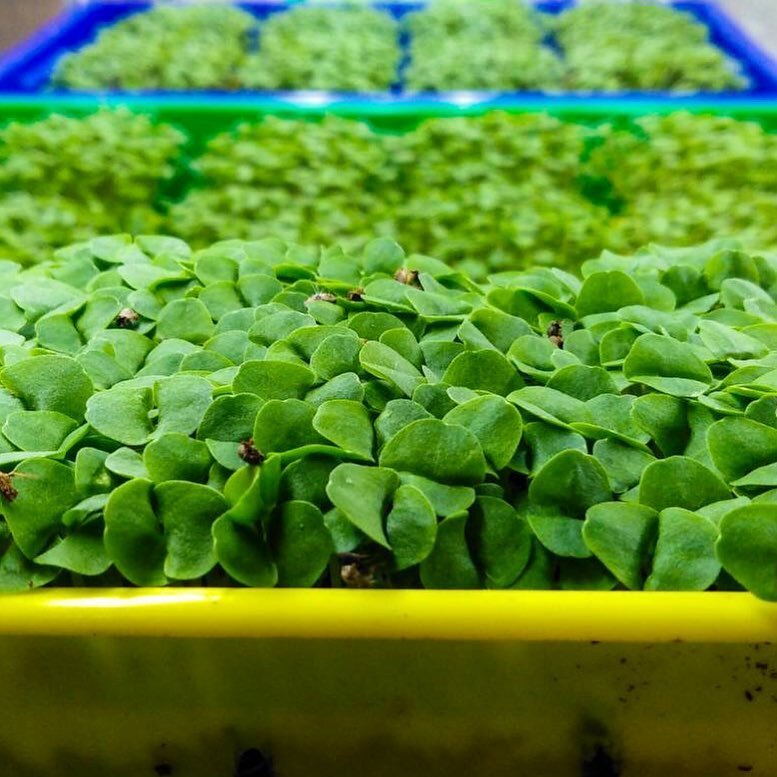Apr 21, 2020
How This Urban Farm Is Supplying A Growing Demand For Microgreens In Manila

Written By: Briana Zagami
Urban Roots is an indoor, hydroponic farm growing microgreens in the heart of Metro Manila. Having started just two years ago, this humble farm is just a 30 sqm space, delivering mainly to diet-food delivery companies, a juicing company, culinary schools, and individuals who order weekly. However, as the nation’s capital continues to battle long transportation miles, high delivery costs, and increasingly frequent typhoons, their goal to build indoor farms across the city has tremendous potential. Martin Escalona, the founder of Urban Roots, decided to grow microgreens because he saw a key opportunity in the market: “there are only a few farms growing that sell [microgreens] commercially, and demand is picking up.”
Urban Agriculture in the Philippines

The Philippines is known for growing crops like mangoes, coconuts, and bananas. While there is a growing demand from consumers for locally grown food, some products that cannot be grown indoors, such as rice, are still imported.
With abundant farmlands around the country, why the need to grow indoors? Despite demands for local food, the challenges of extreme weather patterns such as frequent typhoons, farm-to-market logistical issues due to expensive operational costs, and pests threaten the country’s food supply. Like many other countries around the world, the Philippines is also experiencing an aging population of farmers. Through indoor agriculture, some of these supply challenges can be addressed. Furthermore, urban agriculture is a great way to engage a younger population.
Urban Roots has designed its own indoor hydroponics farm system, a garage transformed into an indoor farm. They currently grow different kinds of microgreens, such as kale, arugula, basil, and purple radish, addressing the high demand and low supply of these products in the Philippines. As consumers become more health-oriented, the potential for microgreens has only grown larger, as the crops offer even higher nutritional value than their mature counterparts. They are now added to grocery lists and featured on menus in restaurants. High-end hotels and restaurants are adding them to salads, sandwiches, or main dishes. Microgreen growers also benefit from these crops’ rapid growth cycle. Despite their fragility, they only have a two to four week harvest time. By growing indoors, Urban Roots can grow microgreens year-round, avoid the need for pesticide use, and reach high growth potential for seed distribution across the Philippines.
Today, Urban Roots serves culinary schools, food and juice companies, as well as private individuals who are interested in the benefits of microgreens. “We never really had a budget for advertising so we rely on sampling, word of mouth, and social media—we are loving this organic growth!” says Escalona.

Typically, reaching a new market segment can be challenging because of the need to educate consumers before they are ready to make a purchase. According to Escalona, “one of the challenges is that customers find microgreens expensive because they think they need to eat a lot of them, but in reality, they just need to complement their existing food with microgreens, like mixing it in an omelet, adding it to your ready-to-eat salad or sandwich mix.” According to Escalona, “Urban Roots is creating a whole new market segment of microgreen eaters.”
Like many urban farms around the world, Urban Roots faces similar challenges, such as getting access to capital, land, and technology. Without support from the government or any agency, it is difficult for urban farmers to build profitable businesses. Escalona notes that “the [Philippine] government is still trying to solve the problems of the traditional farmer in the province, in terms of finance and farm-to-market issues.” The majority of urban growers are self-funded, so without access to capital, it is challenging for a business to thrive. “There should be an aggressive government agency that partners with proven agritech-driven countries to develop both traditional and urban farming in the Philippines. The opportunity is wide open.”
A Bright Future Ahead

The future of urban farming in the Philippines is extremely promising. “We have a lot of unused land lying around. I know a lot of people are interested in home farming just to supply their own needs.” To meet this growing interest, Urban Roots has created their own solution called “Grow Cr8,” partnering with lot owners to grow other indoor crops.
As the country faces the effects of the coronavirus pandemic, Urban Roots is taking part in solving food sustainability issues. Through GrowCr8, they help individuals grow their own microgreens, learn new skills, and secure their own food supply. “Our Grow Cr8 gives the consumer the power to grow greens at home and teach the next generation.” As the farming population in the Philippines continues to age and the stability of the country’s food supply proves to be of utmost importance, Urban Roots sees value in teaching children the benefits of growing their own food—in effect, helping create the next generation of urban farmers.
